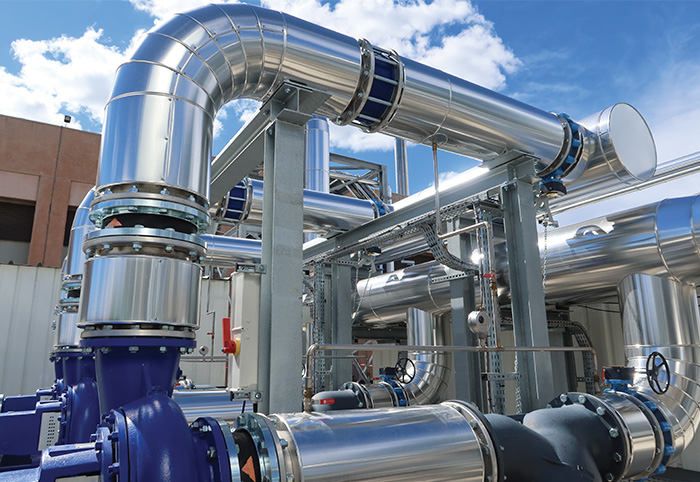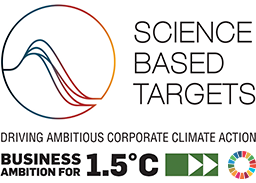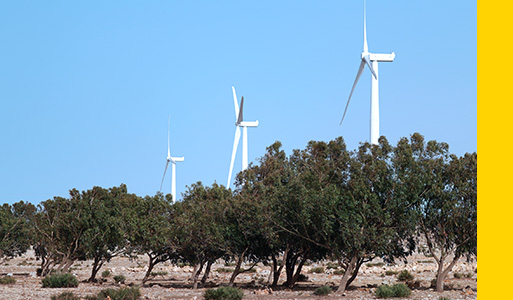Energy and Climate Change
by 2027
At the end of 2020, we announced our commitment to becoming carbon neutral by 2027. This commitment is part of our response to the global climate challenge and reflects our ambition to reduce the impact of our activities on the environment. I 103-1 I
By the end of 2021, we were on track towards our carbon neutrality targets, which include:
- compliance with the Paris Agreement’s 1.5°C scenario by 2025, implying a 50% reduction in direct and indirect greenhouse gas (GHG) emissions vs 2018
- sourcing 100% renewable energy by 2027
To help us achieve these targets, we defined five main workstreams to focus on. I 103-2 I

During 2021, we completed a full review of 14 major ST sites. Each site now has a roadmap to eliminate as much as technically possible all direct emissions, implement additional energy-saving investments and leverage opportunities for renewable energies.
Our comprehensive program
ST has been working on minimizing the impact of its operations on climate change for more than 25 years. The programs in place in all our manufacturing sites address our direct and indirect emissions, defined as scopes 1, 2 and 3 according to the GHG Protocol.
Summary of net CO2 equivalent emissions in 2021 (%) I 305-1 I 305-2 I 305-3 I
Reducing our direct emissions
The use of perfluorinated compounds (PFCs) in the manufacture of semiconductors accounts for a significant share of our direct air emissions, as defined by scope 1 of the GHG Protocol. It is therefore a central part of our environmental strategy to reduce their use and ensure they are treated appropriately before being released into the atmosphere.
PFC emissions
I 305-4 I
Per unit of production – normalized values
CO2 emissions equivalent
I 305-4 I SDG 13.1
Per unit of production – normalized values
Abatement systems
to treat PFCs
In 2021, as part of our commitment to reduce our direct emissions by 50% by 2025 vs 2018, we conducted assessments at all our manufacturing sites to explore the feasibility of introducing additional PFC abatement systems, and which types of system would be best.
Our Ang Mo Kio site (Singapore), one of the highest contributors to our total GHG emissions, has initiated several action plans and investments over the last few years. The site continued these efforts in 2021 by installing 19 systems, reducing direct PFC emissions by 9% compared to 2020. In the meantime, our Agrate site (Italy) reduced its PFC emissions by 8% thanks to the installation of a new thermal processing unit.
As part of our carbon neutrality journey, our Grenoble site (France) installed new uninterruptible power supply (UPS) battery backups to replace the five diesel generators used as electricity back-ups for many years. This will save diesel consumption as well as reduce particle emissions.

Christian Rivolta
Program Manager, Front-end Manufacturing Central Functions
I’m coordinating a cross-site working group looking to optimize process and cleaning recipes and use gases with a lower environmental impact. We are also identifying opportunities for lower energy consumption within the subcomponents of process equipment, such as pumps and chillers. The individual gains are small, but the high number of units installed makes the overall savings noteworthy. I am proud to be part of ST’s journey towards carbon neutrality.”
Saving energy
-18%
energy consumption vs 2020
In 2021, we decreased our energy consumption by 18% vs 2020 (per unit of production), although we slightly increased our absolute energy consumption by 3%, due to a significant increase in production. This demonstrates that the actions we have implemented have improved our energy efficiency.
All our manufacturing sites develop initiatives to better manage and reduce their energy consumption. Environment, health and safety (EHS) teams at our major sites worked on 53 improvement projects during 2021, saving 35GWh of energy.
FOCUS

Innovate to save energy
In 2021, our French sites installed new-generation chillers to improve energy performance and reduce natural gas consumption. The project included installing refrigeration units with energy recovery, which offer two main advantages:
- cooling the clean room production equipment more efficiently than current units
- recovering heat to use for heating sites’ offices
Our Rousset site pioneered and installed a free cooling system that uses the outside air to cool the production equipment, thereby reducing the use of refrigeration units during winter. With this project, the site estimates an energy saving of 3GWh per year.
These projects have reduced the use of gas boilers, saving 1,300 tons of CO2 per year, and have also reduced electricity consumption, saving 6.9GWh per year.
As part of our carbon neutrality program, we conducted external audits of all our manufacturing and R&D sites to identify actions to further improve our energy efficiency. With our partner, Schneider Electric, we identified more than 200 potential actions and selected around 150 of them, which our sites will implement from now till 2027.
Increasing our use of renewable energy
51%
of renewable electricity
Of the total electricity we purchased in 2021, 51% came from renewable sources, compared to 43% in 2020.
Our Bouskoura site (Morocco) is a good example of renewable energy sourcing. In 2021, the site finalized a power purchase agreement with Innovent for wind electricity supply. The wind farm started producing electricity in September and will reach its full capacity in the second half of 2022. With an annual output expected to reach more than 80GWh of green energy, the wind farm should supply at least 50% of the power needs of the site and contribute to reducing its CO2 emissions by about 50,400 metric tons per year.
In 2021, the 1GWh of green electricity produced by the photovoltaic carport at our Bouskoura site (Morocco) partially powered the clean room. Similarly, the solar power installations at our sites in Catania (Italy) and Grenoble (France) produced 2GWh of green electricity.
By the end of the year, as part of the Apple clean energy initiative, we reached the target of supplying products to Apple that are manufactured with 100% renewable energy.
During the year, we also conducted a market study to identify potential green energy projects based on each site’s local context. This analysis will enable us to build a robust and reliable strategy to reach 100% renewable energy sourcing by 2027.
Minimizing our indirect emissions from transportation
3
categories of scope 3 emissions
Reducing CO2 emissions from the transportation of our people and products has been part of our sustainability strategy for 25 years. We report on employee commuting, business travel and transportation of our goods – the three most material categories we can act on out of the 15 categories defined in scope 3 of the GHG Protocol.
We noted a 5% increase in 2021 compared to 2020. This is mainly due to emissions related to goods transportation, which represent 53% of our scope 3 emissions and increased 15% during the year, due to a growth in our business activities and higher production volumes.
As in 2020, due largely to the COVID-19 pandemic, we were able to reduce emissions related to business travel by 28% in 2021 and encouraged eligible employees to work from home.
We also encouraged all employees to develop greener commuting solutions and promote local mobility plans. On this specific topic, our Rennes R&D site (France) organized a ‘mobility week’ with workshops and challenges to encourage more cycling, more car-pooling and more use of public transport. The 89 employees who participated in this initiative saved almost 9,000km of solo driving.
Offsetting emissions
To become carbon neutral by 2027, we will develop reforestation and innovative carbon sequestration programs. To help us achieve this, we worked with our partner, Schneider Electric, to review carbon market options, define project preferences and criteria, and review offset options for future implementation.
Over the year, the 6,200 hectares of forests planted on our behalf between 2002 and 2005 sequestrated(1) 220,500 tons of CO2. However, due to the age of these forests, they are not part of our carbon neutrality program and their impact is not considered in our emissions reporting.
Addressing climate-related risks
We support the
TCFD
Since 2020, when we publicly declared our support for the Taskforce on Climate-related Financial Disclosure (TCFD), we have been working towards implementing TCFD recommendations (see also Risk Management and TCFD index).
We adopt a double perspective when considering climate-related risks:
- impact of our activities on the environment and people
- impact of climate change on our activities
In 2021, our environmental and resilience teams worked closely together to address physical risks resulting from climate change that are either chronic (induced by longer-term shifts in climate patterns) or acute (event-driven) in a way that is consistent with the TCFD and the EU Green Deal classification. This is illustrated in the table below.
|
Temperature-related |
Wind-related |
Water-related |
Solid mass-related |
||
|---|---|---|---|---|---|---|
Chronic |
Changing temperature (air, freshwater, marine water) |
Changing wind patterns |
Changing precipitation patterns and types (rain, hail, snow/ice) |
Coastal erosion |
||
Heat stress |
|
Precipitation or hydrological variability |
Soil degradation |
|||
Temperature variability |
|
Ocean acidification |
Soil erosion |
|||
Permafrost thawing |
|
Saline intrusion |
Solifluction |
|||
|
|
Sea level rise |
|
|||
|
|
Water stress |
|
|||
Acute |
Heat wave |
Cyclone, hurricane, typhoon |
Drought |
Avalanche |
||
Cold wave/frost |
Storm (including blizzards, dust and sandstorms), including medicanes |
Heavy precipitation (rain, hail, snow/ice) |
Landslide (including rock fall) |
|||
Wildfire |
Tornado |
Flood (coastal, fluvial, pluvial, groundwater) |
Subsidence |
|||
|
|
Glacial lake |
|
|||
|
|
|
|
|
||
|
Covered by climate change study |
Covered by specific site studies when required |
||||
|
Covered by water scarcity study |
Non-applicable to ST footprint |
||||
|
||||||
We commissioned a specific science-based study from Axa Climate to assess current and future climate risks on our 140 most critical locations (ST and partner sites in 23 countries). The analysis was based on two climate change scenarios defined by the United Nations Intergovernmental Panel on Climate Change (IPCC):
- RCP4.5 (+2.4°C by 2100 vs pre-industrial levels)
- RCP8.5 (+4.3°C by 2100 vs pre-industrial levels)
For each scenario and for each location, climate projections for 2030 and 2050 show the likely impacts across a range of indicators, such as number of days of heatwaves, high winds, and heavy rain. This allows us to calculate a combined climate-related ‘peril score’ for each location.
We commissioned a second study from Quantis, a specialist firm, specifically focusing on the characteristics and impact of our carbon footprint and water scarcity (see Water).
In addition to these global analyses, site-specific studies on particular natural hazards are also conducted where necessary due to local conditions.
Overall, the purpose of these different climate-related analyses is to inform our site-level business interruption risk assessments and business impact analyses, as well as our site resilience index. Ultimately, they feed into our regularly updated improvement, adaptation, and mitigation plans, addressing environmental and resilience issues.
We are proactively addressing the transition to a lower-carbon economy. In this context, we are in the process of further identifying and assessing policy, legal, technology, and market transition risks. Simultaneously, we are actively investing in researching new products to help our customers develop new energy-saving applications, transforming risk into opportunity (see Sustainable Technology).
Acting collectively
We firmly believe we can achieve more if we act collectively. Our carbon neutrality program aims to engage customers, employees, investors, future employees, and all our partners. We want to implement collaborative programs and partnerships in all our ecosystems to promote carbon neutrality among all stakeholders, and to encourage environmental innovations.

Joining the Science Based Targets initiative
As part of our carbon neutrality program, ST has joined the Science Based Targets initiative (SBTi), which provides a clearly defined pathway for companies to reduce their GHG emissions. By the end of 2021, we were the only semiconductor company with approved targets to limit warming to no more than 1.5°C, demonstrating our high level of ambition.
Transparency towards our stakeholders
By reporting to CDP, we demonstrate to our customers and investors that we are ahead of regulatory and policy changes, we proactively identify and tackle growing risks, and we continually seek new opportunities for action. In 2021, we scored A- in the CDP Climate Change questionnaire. Our answers are available in the CDP platform and accessible to all CDP members.
Third-party audits
11
sites certified ISO 50001
In 2021, we achieved ISO 14064 certification across all our manufacturing sites. ISO 14064 is an international standard for quantifying and reporting GHG direct and indirect emissions at the organizational level. This gives our sites tools and guidance to select the appropriate GHG sources, data, and methodologies, and enhance our reporting.
Similarly, ISO 50001 certification helps us to improve energy efficiency and so reduce GHG emissions and energy costs. Our Bouskoura site (Morocco) joined the 10 ST sites already certified (see ST certifications).
Contributing to the Sustainable Development Goals
Our commitments and programs related to Energy and Climate Change as described above contribute to:
SDG target 7.3 – By 2030, double the global rate of improvement in energy efficiency.
SDG target 8.4 – Improve progressively, through 2030, global resource efficiency in consumption and production.
SDG target 13.1 – Strengthen resilience and adaptive capacity to climate-related hazards and natural disasters in all countries.
2027 sustainability goal |
Status |
Comments |
SG9: Be carbon neutral by 2027 in all direct and indirect emissions from scope 1 and 2, and focusing on product transportation, business travel and employee commuting emissions for scope 3. |
1,044 KTCO2 |
|
SG10: Adopt 100% renewable energy sources by 2027 through energy procurement and green energy installations. |
46% of total energy |
|
SG11: Implement programs to reduce energy consumption by at least 150GWh per year by 2027. |
35GWh savings implemented in 2021. |
2025 sustainability goal |
Status |
Comments |
SG12: Reduce energy consumption per wafer by 20% in 2025 vs 2016. |
-19% |
|
80% of renewable electricity by 2025. |
51% |
|
-50% absolute scope 1 and scope 2 GHG emissions by 2025 (2018 baseline). |
-34% |
(1) Internal calculation method.


